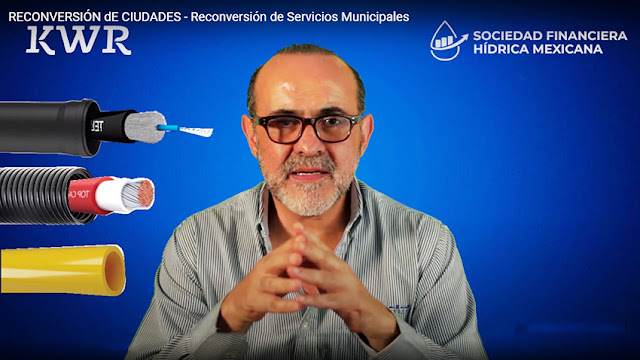Guadalajara opts for potable water plan
In May of 2019, the city of Ciudad Guzmán, Jalisco, announced implementation of a radically new water and utilities distribution system—based on cutting-edge Dutch technology—that would rid the town of its tinacos (water tanks on rooftops) as well as ugly telephone and electrical wires stretched above its streets.
Representatives of the Mexican and Dutch companies involved promised that, after only three years, members of every household in Ciudad Guzmán would be able to drink potable water from their kitchen taps.
Alas, the three years expired last month and the tinacos are still there on every rooftop in Ciudad Guzmán.
Coincidentally, last month, businessman Raul Mejorada of Guadalajara’s Grupo MGB Victoria, announced a decision of the City of Guadalajara to opt for implementation of the very same technology to transform the way water, electricity and other utilities reach consumers in Mexico's second-largest City.
"But whatever happened to Ciudad Guzmán?” I asked Mejorada.
"The plan," said the businessman, "depended on the state of Jalisco supplying 50% of the funding needed. They dropped out at the last minute and everything fell through."
Mejorada laid the blame squarely on the way Mexico handles the taxes it collects. Businesses located in cities and towns pay taxes to the federal government, "but,” said Mejorada, “the federal government gives back only 18 percent of that money to the states and a mere four percent to the municipalities."
This means Mexico's municipalities are poor, and therefore no one will lend them money.
“But hold on!” says Mejorada. During the last three years, he and his Dutch colleagues have come up with a solution to this financing problem:
They are asking any city that wants this new technology to cede its utility-distribution rights to a fideicomiso, a trust. Members of the trust include his company MGB Victoria and the KWR Foundation, a unique fusion of Dutch companies and a water research institute, but the fideocomisario, the trustee, is the municipality itself, which is also the beneficiary of the trust. In the case of Guadalajara, this trust is called Sociedad Financiera Hídrica Mexicana.
While the municipality is poor and can't get credit, the trust is wealthy and can get plenty of financing.
However, it must be demonstrated that the transformation of a city’s utilities-distribution system will be able to pay for itself. So, Mejorada and his assocates came up with a plan by which the new system is not only cost-effective, but profitable as well.
“To make the system profitable for the township,” says Mejorada, “we add to the water-distribution system other services which can generate money. So, alongside the tube of potable water (which, by the way, is self-cleaning) we put a flexible tube carrying natural gas and a telecommunications tube for internet, cable and telephone, replacing airborne telephone wires which are very expensive to install and maintain. And we also supply a tube carrying electricity exactly the same way, underground, not through wires in the air. In this way, the program becomes sumamente rentable, highly profitable. Why? Because the utility companies which will benefit, will all pay rent and this will pay for the infrastructure.”
The new distribution system is entirely underground, using new, non-invasive tunneling techniques, and because none of the tubes—which are actually tough, flexible hoses—is more than four centimeters in diameter, the cost of installation is very low.
Mexico’s present water-distribution system loses a full 50 percent of the water it attempts to carry.
“We need to stop this,” says Mejorada, “with new technology, and Holland has that technology, in the form of small, open-ended distribution networks which are different from any other country’s. Holland only loses three percent of its water.”
I asked Raúl Mejorada which neighborhood of Guadalajara will be the first to benefit from his project.
“The answer is easy,” he said. “We will start wherever it will be more profitable and easier to install. And because these are basic utilities, there will be more profit where there are more people. So we will focus first on areas where there are plenty of customers. We will start in the poorest, most crowded parts of town.”
A likely candidate for the first utilities revamp is Balcones de Oblatos, a colonia (neighborhood) at the east end of town overlooking the deep Santiago River Canyon and noted for having “lots of people and lots of potholes.”
Mejorada says the municipality of Guadalajara has already paid for a preliminary study “and we expect that the process for approval will take about eight to ten months. After that, the works will begin and the first areas renovated will be generating funds for more and more sectors of the city.”
Similar plans, it seems, are underway in Zapopan and Chapala, where the village of Ajijic will be one of the first to experience the utilities upgrade.
Says Mejorada: “In my opinion, the chance that this project in Chapala will be in operation next year are one hundred percent. We are talking about packages of 9,000 tomas, (connections or outlets) and Ajijic will need only 4,000, so we will be working in other areas along the lakeshore. Once we start, we won't be stopping, because every time we connect a new customer, we are making money; the municipality is making money. So, one day I hope to see Chapala free of overhead wires.”
Raúl Mejorada and his team went to great lengths to find a way to implement a badly needed project at the municipal level. Here is his final comment on the crusade he has been waging for years: “The wealth of our country is generated in our municipalities and the day we realize this, we will see a better, fairer and richer Mexico.”








Comments
Post a Comment